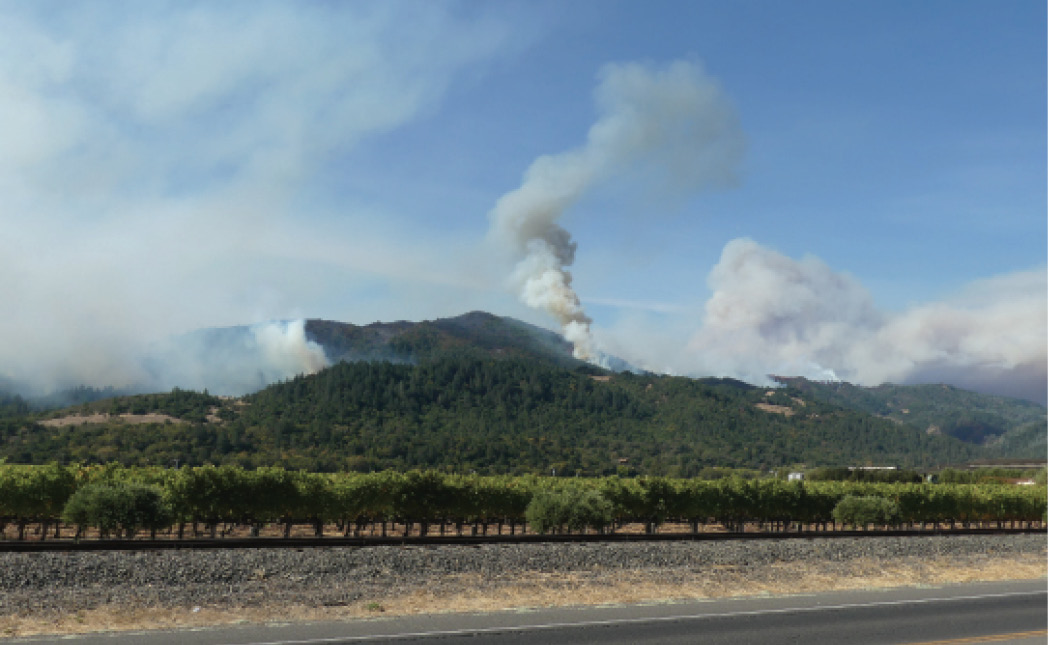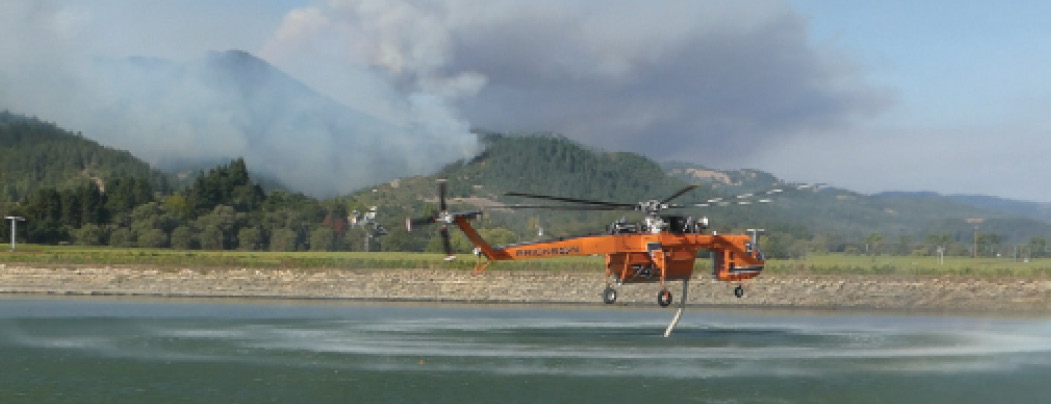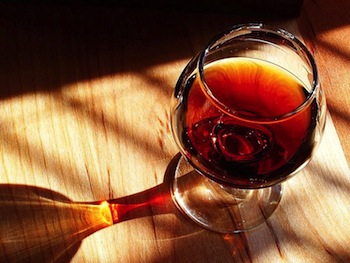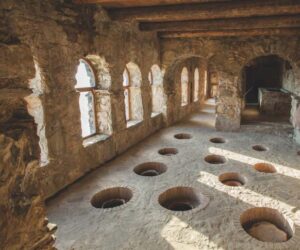
I was taking my puppy out for a nighttime walk when I first smelled the smoke. It was 11:30 p.m. on Sunday October 8, 2017 and we had just picked up Huey, a 10-week-old Australian Shepherd, from the breeder the previous day. I wasn’t surprised that there was a fire somewhere; the city of Napa had issued a red flag wind warning that afternoon and we were accustomed to late-season flare-ups in the hills. Huey and I headed back inside, he to his crate in our bedroom and me back to bed. After Huey’s 3:00 a.m. outing, however, I wasn’t so nonchalant about the smoke that had since thickened outside. “This is serious,” I said to my husband as I gently shook him awake. “That fire is either really close or really big. I’m going to go check it out.”
I pulled on a vest, grabbed a flashlight and my phone, and got into the Subaru. Before I pulled out of the driveway I quickly checked Facebook; it had just started to light up with friends reporting a fire up in Calistoga. Then someone said Silverado Country Club, on the eastern side of the valley, close to downtown Napa where we live and work, was on fire. Then someone posted that they were evacuating the Carneros Inn, only a few miles from our house down in southwest Napa County. It seemed like the Napa Valley was surrounded by fires. I turned on the headlights and turned south on Hwy 29 to try to get a sense of what exactly was going on.
Surrounded by Fires
My sense of confusion and rising panic was nothing to what others were experiencing. Unbeknownst to most Sonoma and Napa County residents, by 3:00 a.m., the North Bay firestorm complex had already destroyed hundreds of buildings, killed over 20 people and was on its way to becoming the most destructive and costly fire in California state history. Though exact causes are still being investigated, it is believed that record-high winds downed power lines and sparked numerous fires in Napa, Sonoma, Mendocino, Lake, Butte, and Solano counties that night. As the Tubbs, Atlas, Nuns, Partrick, and other fires roared through the hills around Napa and Sonoma Counties, police, and in many cases, neighbors, ran door-to-door, shouting for those in danger to get out. Many barely escaped with their lives; some, 43 in all, did not.
In those early hours of Monday October 9, as I turned west into Carneros towards the town of Sonoma, through this rural landscape of rolling vineyards, I couldn’t believe what I was seeing. To the north of me, entire hilltops were on fire. These were the low mountains behind such properties as Artesa, Domaine Carneros, and Hyde Vineyard. To the east, amid Napa County’s Atlas Fire, Signorello winery was going up in flames just off the Silverado Trail. On top of Mt. Veeder, Dr. Carole Meredith, the famed Zinfandel researcher and my old UC-Davis viticulture professor, along with her husband Steve were getting ready to flee their home winery and vineyard. In Mendocino County, Frey Winery was under threat and, as we would learn later, sadly was destroyed. That night, though I was turned around at a roadblock, one of my company’s own Carneros vineyards had fires burning all around its edges; we lost a barn and two outbuildings. As the night turned to a red and smoky dawn, the realization that wine country was on fire began to spread.
Wildfire and Wine
As the week wore on we realized that of 500 wineries in Napa County, 7 were reported destroyed and 9 seriously damaged. Sonoma County reported 3 destroyed and about half a dozen wineries reporting serious damage. The real destruction lay in the residential areas around Santa Rosa, where a combination of freak winds and tornadoes of fire turned urban neighborhoods into an unlikely moonscape of ash and destruction. In one night, Sonoma County lost over 5,000 buildings, most of them homes.
Luckily, about 99% of California’s grape harvest was complete before the fires started and 90% of Napa and Sonoma County’s fruit was in the barn. That being said, harvest was still in active mode for many of us. Some wineries didn’t have power for a few days. Some, especially those on Silverado Trail and on Highway 12 near Sonoma’s Glen Ellen and Valley of the Moon, were evacuated off and on for a week. Harrowing as this time was, I witnessed an incredible outpouring of support and derring-do among the winemaking community as winemakers unaffected reached out to those in need with offerings of crush space, barrel storage, and a safe place to evacuate wine libraries. Generators were hauled in, harvest interns were housed, and pizza was brought for hungry crews still working night shifts, respirators now on full-time to ward off the smoky air on the crush pads.
Will the 2017 vintage be affected by the fires? My two fermenters of Oak Knoll Cabernet Sauvignon seemed to survive just fine without two days of pump-overs. Maybe we’re being too aggressive with our extraction anyway. Will there be any smoke taint issues? Dr. Anita Oberholster of UC-Davis Extension has done a good job of debunking the idea that ambient smoke inside (or even outside) a winery will impact wines in tanks, barrels, and bottles. The remaining question regards any grapes still hanging on the vine during the fires. I’ve spoken with experts from Washington State University, ETS Laboratories, and UC-Davis, and the consensus seems to be cautiously optimistic. All my winemaking friends who dealt with the 2008 Mendocino County fires where smoke lay thick on the vines there for weeks have told me that it takes weeks to have a big impact. The North Bay Wildfires started on a Monday and were largely out within a week. Since smoke taint is a microbially and enzymatically brokered phenomenon, experts say the sensory effects won’t be final until primary and malolactic fermentations are complete and even then, perhaps not until six months out. We will have to wait and see.
The journey to recovery
It turns out we never had to evacuate. We didn’t find out until ten days after the fire started that two courageous men, Eli Ponce and Dan Wynn, cut fire lines with their bulldozers for 48 hours straight, essentially preventing the Carneros-area fire from spreading into West Napa towards our neighborhood. Even though I’m grateful we didn’t have to get out, it’s going to take a long time for those of us affected by these fires to get back to normal. Though we never had to officially evacuate (I sent my kids, husband, and pets away just in case) I’m still putting away boxes of precious things that I was fortunate enough to never have to load into the car. Our singed vineyard rows will bounce back in the spring and at work we laugh about the barn that we lost; it was an old eyesore anyway. The real scars lie deeper and out of sight. The green grass budding up through the black rubble disguises an undercurrent of uncertainty that persists for so many: For our tasting room worker and friend John, whose place up on Mt. Veeder is uninhabitable and who’s been living with us since the fires, for the Santa Rosa landscaping crew without a neighborhood to landscape, for the housekeeper who along with her key clients is now also homeless.
You can help us by continuing to buy and drink Mendocino, Napa, and Sonoma County wines, and of course by coming to visit. It also helps if you can spread the word that no, the 2017 vintage will not be ruined by these fires and, contrary to how it may have appeared in the national media, California’s Wine Country did not burn down. We remain the beautiful place you’ve always known and loved.
After the air cleared towards the end of October, driving up Hwy 29 to check on my fermenting 2017 wines was still one of the most gorgeous commutes imaginable. In Sonoma the fires unfortunately consumed so many residential areas, while in Napa they were largely (and luckily) contained in the sparsely-inhabited hills where there are many oak and pine trees and few wineries. This means that so much of what makes us great — the wineries, restaurants, lodges, and spas — is still here. Most importantly, the people who love this place and call it home are still here and can’t wait to show it off to you. Where flames towered scant months ago, I can see gorgeous patches of green up on Napa’s mountains. Time to take Huey for another walk.







